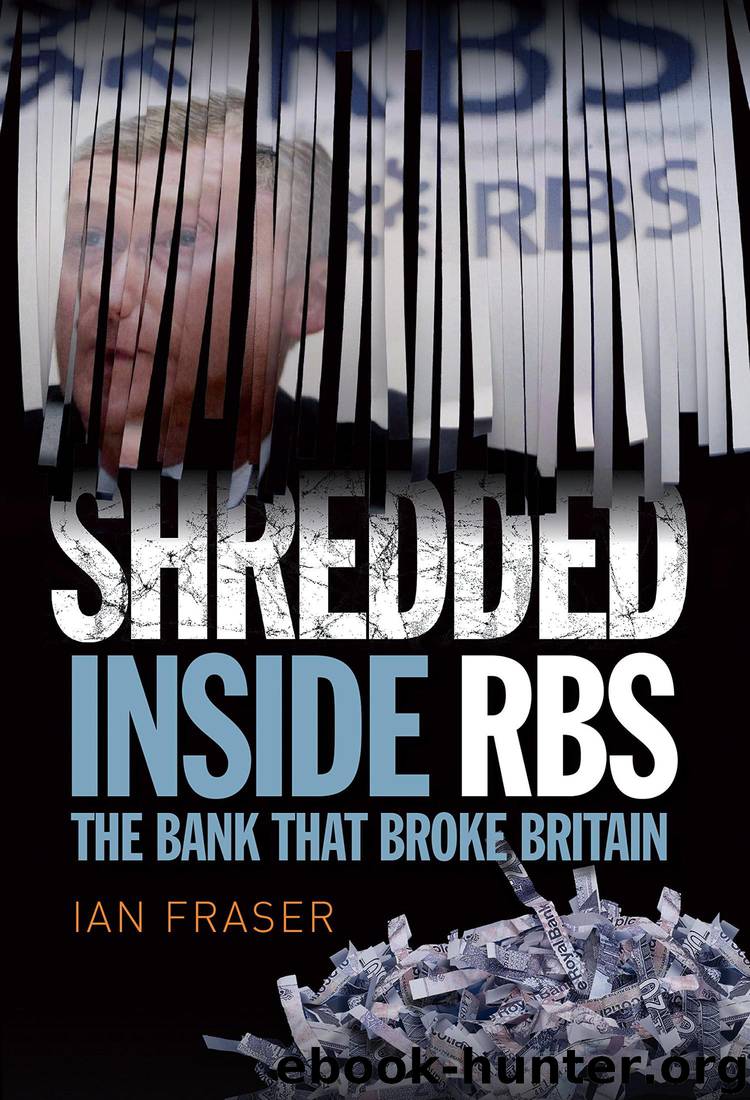Shredded: Inside RBS: The Bank That Broke Britain by Ian Fraser

Author:Ian Fraser
Language: eng
Format: mobi
Tags: Europe, Human Rights, Biography & History, Politics & Social Sciences, Politics & Government, Political Advocacy, Economics, Company Histories, Biographies & Memoirs, Practical Politics, Industries, Great Britain, Business & Money, Historical, Elections & Political Process, International, Banks & Banking, Specific Topics, Company Profiles
Publisher: Birlinn
Published: 2014-06-04T22:00:00+00:00
26
Explosions at ABN
At an investor lunch in Edinburgh’s New Club, the favoured watering hole of the Scottish establishment, Colin McLean, chief executive of SVM Asset Management, questioned Goodwin’s strategy. To most investors around the table, Goodwin was a local hero. He had transformed RBS into a global force and was putting Scotland on the map as a financial centre to rival London, Paris, Frankfurt and Geneva. To criticise him, at that point – it was 13 November, just a month after the ABN victory had been proclaimed – was heresy. There was polite disbelief around the table. The chief executive of another Edinburgh-based asset-management firm rubbished McLean’s views. He said, ‘If there was anything wrong with RBS, Fred would have told us.’ But McLean, known for his skills as a short-seller of financial stocks, told the assembled company of investment professionals that, in his view, RBS was overstretched. McLean said, ‘Superficially, RBS’s capital ratios may look good [but] they’re backed by a lot of “rubbish”.’ Asked to elaborate, McLean said, ‘Royal Bank does not have enough tangible assets in its core tier-1 capital – there’s too much goodwill and funny paper – and Fred keeps diluting the balance sheet through acquisitions.’1 He then delivered his coup de grâce, saying that the bank would probably be unable to pay a dividend. ‘There was a stunned silence for 30 seconds,’ recalls McLean.2
McLean, of course, was right. The RBS balance sheet was stuffed with rubbish and it was severely overstretched, due to the difficulties of funding two giant banks that were overdependent on a diminishing commodity – wholesale interbank finance. On top of this, it was also being pushed into a corner by the De Nederlandsche Bank (DNB). The Dutch central bank was insisting that RBS took regulatory and management control of the whole of ABN AMRO, whilst including the entire bank – which, at the time, had total assets of €1.025 trillion – on its balance sheet. That meant RBS would have to take responsibility for the whole of ABN for months, if not years, while various limbs were amputated and handed over to its consortium partners, Fortis and Santander. This would turn out to be another ticking time bomb for RBS.
On 11 October, Goodwin unveiled a new top management team for the Dutch bank. He appointed trusted lieutenant Mark Fisher as chairman of ABN’s management board, which meant the Yorkshireman was effectively taking the reins from Rijkman Groenink. City scribblers welcomed the appointment since Fisher was seen as a superb ‘nuts and bolts’ integrator who had done an excellent job on NatWest. Brian Crowe, who was suffering from a kidney-related illness, was replaced as deputy head of GBM by RBS’s leveraged-buyout chief Leith Robertson, his deputy, on an interim basis. This freed up Crowe to take the reins at ABN AMRO’s global markets business from Piero Overmars, who continued to run Asia and Europe, while the chain-smoking ABN executive Wilco Jiskoot handed over control of global clients. Both Jiskoot and Overmars agreed to remain on the ABN managing board for the duration of the integration.
Download
This site does not store any files on its server. We only index and link to content provided by other sites. Please contact the content providers to delete copyright contents if any and email us, we'll remove relevant links or contents immediately.
International Integration of the Brazilian Economy by Elias C. Grivoyannis(90827)
The Radium Girls by Kate Moore(11921)
Turbulence by E. J. Noyes(7935)
Nudge - Improving Decisions about Health, Wealth, and Happiness by Thaler Sunstein(7615)
The Black Swan by Nassim Nicholas Taleb(7010)
Rich Dad Poor Dad by Robert T. Kiyosaki(6399)
Pioneering Portfolio Management by David F. Swensen(6226)
Man-made Catastrophes and Risk Information Concealment by Dmitry Chernov & Didier Sornette(5921)
Zero to One by Peter Thiel(5685)
Secrecy World by Jake Bernstein(4643)
Millionaire: The Philanderer, Gambler, and Duelist Who Invented Modern Finance by Janet Gleeson(4374)
The Age of Surveillance Capitalism by Shoshana Zuboff(4209)
Skin in the Game by Nassim Nicholas Taleb(4161)
Bullshit Jobs by David Graeber(4094)
The Money Culture by Michael Lewis(4076)
Skin in the Game: Hidden Asymmetries in Daily Life by Nassim Nicholas Taleb(3929)
The Dhandho Investor by Mohnish Pabrai(3698)
The Wisdom of Finance by Mihir Desai(3650)
Blockchain Basics by Daniel Drescher(3506)
